Top notch chefs prepare for Sacramento’s first-ever burger battle
The first time Rodney Blackwell bit into a McDonald’s Quarter Pounder, he fell in love. But that was child’s play.
Blackwell, a Sacramento resident, entered the burger big leagues as an adult, ordering variations of the classic stack at fine diners, five-star restaurants and food trucks across the country.
In search of the perfect relationship between bun, patty and condiments, Blackwell started the blog and informational site http://burgerjunkies.com/. His tastes quickly sharpened as he approached burgers no holds barred. A patty topped with fried eggs? Do it. Fiery habañero sauce? Sure.
However, he still couldn’t decide on Sacramento’s champion burger. After attending the Denver Burger Battle, Blackwell realized a side-by-side comparison might answer the question and would also allow locals to vote for their favorites.
“I got inspired at the Denver Burger Battle,” Blackwell says. “It had sold out. There were 12 restaurants, people having a good time with great energy. I wanted to bring that to Sacramento.”
The goal of Blackwell’s burger battle on Sept. 18, 2012 at Raley Field in West Sacramento is twofold: to showcase the dining scene available in the Sacramento area and to raise awareness and much needed funding for a great cause.
Blackwell’s 9-year-old daughter Karina has battled with Crohn’s disease for the past four years. According to the Crohn’s and Colitis Foundation of America, the disease is a chronic inflammatory condition of the gastrointestinal tract that affects more than 700,000 people, causing loss of appetite and energy, and sometimes slowing growth and development in children.
“My daughter was diagnosed years ago and since I can’t cure the disease myself, I figured I’d do what I can to help those that are trying,” Blackwell says.
All the proceeds from the Sacramento Burger Battle will be donated to the local CCFA chapter. Blackwell had already raised $12,000 since announcing the battle, and tickets for the event are still available.
“For charity it’s a great feat in and of itself, but I’d still like to sell out tickets,” Blackwell says about the current donations and sales.
The $55 entry ticket covers the generous burger samples from 15 high-caliber restaurants; craft beer from Sierra Nevada, Ruhstaller and Lagunitas; wine tastings from Crystal Basin and Perry Creek; Woodchuck cider; non-alcoholic beverages; live music and parking.
Attendees will have to pace themselves with the burgers–despite being sample-size, several chefs plan to pack big flavors into those few bites.
Chef Jose Silva, known for his exotic meat patties at the Flaming Grill, says judges and attendees might get their chance at trying wild boar, antelope, goat, camel or even kangaroo.
“We try to keep it simple–with a good bun and sauce and high quality meat,” Silva says.
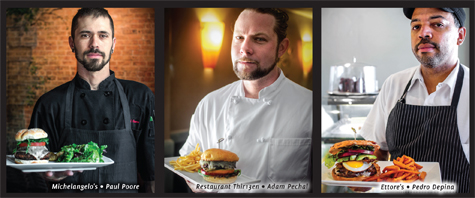
For Chef Pedro Depina of Ettore’s European Bakery and Restaurant, the burger bun is extremely important in making a top notch burger, “because it’s the first thing you taste.”
“We’re going to let our bun speak for itself,” Depina says, noting the buns are made at Ettore’s. “Then comes the meat, and we use all natural Niman Ranch.”
As for the other ingredients, Depina says freshness, quality and the marriage of the flavors are the best ways to know a burger is made well.
“We’re going to keep it classic,” he adds of the Ettore’s entry. “No bells and whistles, just in your face.”
Asked which Sacramento burger is his favorite, Depina has no shame.
“The one we make here, I eat one once a week, but don’t tell my wife,” he laughs.
Other major players in the battle include burger award-winner Thir13een, de Vere’s Irish Pub, Kupros Bistro, Shady Lady Saloon, The Porch, Squeeze Inn and several others.
“All the chefs, we’re all good friends,” says Depina. “We eat at each other’s restaurants so this will be a friendly throw-down.”
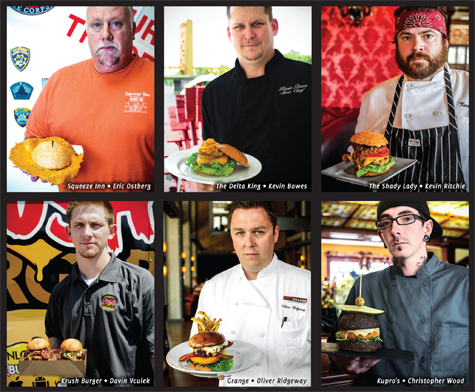
One local chef is not competing, but judging. Bret Bohlmann, chef and owner of Boulevard Bistro in Elk Grove, will be one of five judges. Blackwell says he reached out to Bohlmann because he makes a great burger, but his restaurant no longer has it on the menu so he figured judging would be his next best option.
Other judges include Congressman John Garamendi, food writer and blogger Erin Jackson, Corti Brothers Food Director Rick Mindermann and Executive Chef Mike Ward of Feeding Crane Farms.
Though Bohlmann has never judged a burger competition, he does have an idea for his approach that day.Â
“First, it has to be visually appealing,” he says.
Then, he adds, the burger must have quality ingredients and be cooked properly.
From there, judges will look at the kinds of extra ingredients used and whether those ingredients “marry well–belong together so that when you take a bite, everything works,” says Bohlmann.
One concern Bohlmann does have is burning out on burger too early, meaning after a few, he doesn’t want all the different entries melding together to cause faulty judging.
“A burger is quite fatty. A meat patty can have 15 to 20 percent fat, which coats your mouth, so we need a palate cleanser,” he says. “It’s something to think about because you want to taste everyone’s unique creation.”
A light, refreshing pilsner might do the trick.
Bohlmann is also hoping the burger challenge will spark continued creativity to the already impressive menus and styles now available in Sacramento.
“I think this will make people rise up and create something new for their menus,” he says. “In the last 10 years we’ve really grown. Zagat came through and rated everybody, and we’re really putting our mark on California.”
Depina adds that the culinary landscape of Sacramento has changed for the better during the 20 years he’s been in the business, and a competition like this is comparable to other California cities that boast the best in dining.
“Sacramento is one of the heavy hitters in the food industry now, like Napa and San Francisco,” he says. “You don’t have to travel all the way over there to get good food. We’re the breadbasket of the state, with all this good local produce. We’re all pushing to eat in our own neighborhood, our own backyard.”
Blackwell has been doing just that for many years, but says he is looking forward to what the chefs come up with for the burger battle.
“I’ve tried them all, so I’m looking forward to trying them side by side,” Blackwell adds. “It’s hard to say when you spread out eating them one week at a time which is best. All of these are some of my favorites I’ve tried and reviewed.”
Blackwell also recently received a call from an organizer of the World Food Championships, which will be held in Las Vegas in November, asking if the burger battle could be used as a qualifier for the championship.
The stakes have been raised a bit because of this announcement, Blackwell says, but he feels the burger chefs of Sacramento would be able to represent their country well if any of them makes it to the world competition.
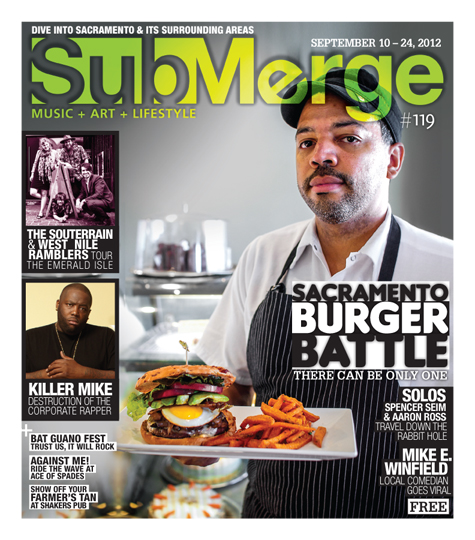
Sept. 18 is National Cheeseburger Day, and also the date of the Sacramento Burger Battle. This will be a slobber knocker of meaty proportions, so don’t miss out. For more information or to buy tickets, visit Sacburgerbattle.com. You must be 21 years or older to attend. Eat hearty knowing the proceeds will go toward a worthy cause. To learn more about the Northern California chapter of the Crohn’s and Colitis Foundation of America, go to http://ccfa.org/chapters/northerncalifornia/.
Urban artist Lady Remedy gets ready for her big debut
Wearing sweet kicks, acid-wash skinnies, sports memorabilia and shades, Lady Remedy walks up to Kasbah Lounge on J Street like she’s done it a million times. Midtown is her neighborhood, Sacramento is her home. And now that this smooth-talking wordsmith/producer has turned her sights to singing and MCing full time, she says she’s ready to go beyond her streets.
Before Lady Remedy, there was Tori Redd. Redd wrote, produced and hung out quietly around the Sacramento hip-hop scene in which she grew up. She loved the music but didn’t really want the attention.
Fast-forward a few years and the spotlight’s just the beginning.
Remedy’s first EP, Freak, with eight songs–including her single “The Way U Do” out now–releases digitally July 26. [Submerge has received word that this release date has been pushed back. Check http://www.ladyremedy.com/ for up-to-date info on the album’s release.] A 13-track mix tape, The Steez-Tape, is already available online and also showcases Remedy’s producing skills. She’ll follow those up with an 18-track reloaded version of her EP, more music videos and at least four other projects, including an all-female MC compilation called Venus x Bars and her label Block Starz Music’s compilation album, of which a few more installments are in the works.
And of course, the touring to promote all this music starts soon, with an official kick-off lined up during San Diego Pride Week, July 21, 2012.
Before recording, Remedy spent the last two years highlighting what she could do on stage, in person. Now she wants to see what the world thinks of her music.
“Since I’ve been performing out as an artist, I haven’t been putting out music, which is good too, but I don’t think people have a complete perception of what I do and who I am so the music is important to me,” she says. “This will show my position as an artist.”
Remedy’s catchy, throwback style falls into the realm of singers like Brandy and Queen Latifah, as well as rappers like the late Notorious B.I.G. and one of Remedy’s influences, Jean Grae. Remedy is hip-hop, but more.
“I am very much an urban music enthusiast,” she says, pulling up to her hookah at Kasbah Wednesday night. “It’s kind of watered down now because everybody feels like in order to be mainstream you can’t really do urban but mainstream is urban to me. It’s kids and people who are living life in the streets, or living life just out in the world; that’s urban. Those who say urban is just hip-hop, that’s not true. It’s real music.”
Remedy is a lyricist first and foremost, but she says she also wants to show her balance of singing and emceeing, and be the best at both.
“I try not to get boxed in but it’s hard,” she says. “People always ask, ‘Do you like to sing more or rap more?’ It’s fun to do both. When I sing it’s like a different part of me. I can be sweet, soft, sensual, whatever. Soulful and very emotional. Same with MCing, I can talk about subjects that can draw emotion, and just be transparent. Emceeing is a little bit more exciting because it’s more in your face, parental advisory, ha ha, but I don’t like people saying I should be doing one more than the other.”
What listeners may not know is that Remedy started out in soul, singing backup or producing and writing. She’s transitioned into a performer easily because of her past experiences with Sacramento-based R&B/soul artists like Marknoxx, her music partner, and brings the neo-soul, new age vibe she started with to her music now.
“I was always working, producing and writing with local artists and working with whoever knew what I did in music,” says Remedy. “The spotlight never appealed to me. I thought, I just want to write songs. But when I stepped out I got a really warm welcome, and it gave me more confidence and made me want to continue on and grow more.”
Working behind the scenes paid off. Local hip-hop musicians Righteous Movement featured Remedy on their tracks and Turf Hop Alliance, a collective started by local MCs Remedy knew well pulled her into the group. Coupled with her musical relationship and vocals with Marknoxx and the Young Legends, Remedy was set.

“So when I started rockin’ I was affiliated with all these artists and so the same audience who saw them saw me,” Remedy says of her first shows. “Being one of the only girls, they were really excited to see another female doing it so it was a good start.”
When Remedy joined Block Starz Music, the label helped her get more viral attention. Block Starz is also releasing her upcoming albums and mix tape, and has included her on available and upcoming compilations and booked her summer tour dates.
Other upcoming projects include a Turf Hop compilation coming out soon for which Remedy shot a video June 24.
“I wasn’t shooting videos before…Lady Remedy, but it’s fun,” she says, noting her brother, Los Angeles-based photographer and creative director Tyren Redd, has shot all of her prior videos. “Especially when you’re getting into singles and songs that mean something and you want to do a whole story and be artistic and creative. It’s cool to put it out and see how people react to it.”
So what’s this 24-year-old music maker doing when she’s not working? For now, she’s getting ready to move to L.A. “to be seen” more and launch her music statewide. Remedy also has multiple other talents, from basketball to graphics, and she weaves the two into her career when possible. The laid-back sneaker-holic also loves to buy more kicks–her single “Sneaker Freak” is the plain truth–and she rides her fixed-gear around Midtown before sitting down to play video games.
Remedy’s relaxed, comfortable attitude reflects in her quick-hitting lyrics that rely on her life experiences and clever pop culture references, but that doesn’t mean she’s not anxious about her big debut.
“The EP release party is July 25 here at Momo Lounge–Oh my gosh,” she stops and laughs. “I’ve never done anything like this. I think every artist is sensitive about their music. They put it out there. Even a mix tape–it’s just a mix tape but it’s the first thing I’m putting out, so it’s like, you know, I just want it to be received well.”
A welcome reception in her hometown might help, partly because, Remedy says, the talent in Sacramento goes largely unnoticed. If artists like her make it big, she’s hoping more attention will come this way.
“I think it’s a good place to say you’re from, especially with the push that a lot of us are giving right now, we’re reaching masses and that’s bringing attention to Sacramento,” she says. “Eventually everyone [from here] working as hard as they are in music, it’ll turn into something and we can say, ‘I’m from Sacramento,’ and people will be looking for talent in Sacramento. For now, it’s not all the way like that but it’s good we’re going out and bringing attention to where we’re from.“
She continues, “I think Sacramento’s dope. People don’t know. Even for the other genres. Alternative bands, rock bands, we got great hip-hop acts, we got amazing singers, there’s so much talent here, people just don’t know.”
With all that’s in store in the coming months, Remedy says she’s excited about reaching out. Some of the shows she has lined up will be in Sacramento, but she is very focused on the whole state.
“But like I said, I’m from here, and it’s important to get the support of Sacramento,” she says. “I’m excited about reaching out. Reaching back actually. My region, my area, my city.”

Lady Remedy will celebrate the release of her new single “Give It To Um” on July 25, 2012 at Momo Lounge. The show gets underway at 10 p.m. and is presented in conjunction with L!FE. She will also have a show at Shenanigans on Aug. 4. To hear Lady Remedy and get the latest info about release dates and the tour, visit http://www.ladyremedy.com/.
Community celebrates fine artist Milton 510 Bowens’ 20 years of service to art and education
Beatnik Studios on 17th between Broadway and X Street blends harmoniously with Milton 510 Bowens’ latest solo exhibition, Echoes of the Sweetest Sounds.
The former is an urban loft-style gallery made of brick that brings photography, music and local artistry to a shared space. The latter is a well-honored fine artist’s resolve to educate about music, history and social justice through art.
Echoes… celebrates 20 years of Bowens’ work with pieces never before seen in Sacramento and gives a unique spin to this year’s local Black Music Month events (renamed African-American Music Appreciation Month by President Barack Obama).
In the last 20 years, Bowens has reshaped his philosophy as a fine artist and taken the approach of a community activist and documentarian. Since, he has achieved great recognition nationally. Starting in 2009, his art became part of the syllabus for a course study in the Harlem Renaissance at Cornell University’s Africana Studies and Research Center. He is also a spokesperson for the K—8 art immersion program Any Given Child in public schools across the country in conjunction with the Kennedy Center for the Performing Arts in Washington, D.C.
Bowens has had paintings showcased at the National Civil Rights Museum in Memphis, Tenn.; been touted by local newspapers as having the largest solo exhibition (150 large pieces) in the United States in his hometown of Oakland; received this year’s Sacramento Artistic License Award; and received a resolution from the California Legislative Black Caucus for his work on arts and education in public schools.
Undoubtedly, this unconventional exhibition has a message.
“After you’ve done something for 20 years, it’s hard to choose what to show, but instead of doing a montage of random pieces…I chose those [pertaining to] music,” Bowens says, leaning back and looking relaxed on a sofa at the gallery after grabbing lunch at Slice of Broadway. “Beatnik, jazz, counterculture…it all goes together.”
The pieces come from Bowens’ Afro-Classical collection and some from his Soul Music series. He journeys through the jazz era and its historical importance in Afro-Classical with recurring images of everything from records, piano keys and musicians’ portraits to railroad tracks, slave ownership documents and tally marks. On his pieces, he writes what he feels, quotes that he admires and pushes the viewer to take a closer look, “Don’t just hear what the work is saying, listen.”
Bowens mixes media with organic materials like cloth, doilies and prints for “richer depth and more substance.” In pieces like God Bless the Child and Straight No Chaser, the use of children’s building blocks and rope along the top of the canvas adds another three-dimensional element.
“I am trying to poetically encourage people to linger a little bit,” he says of his collages with lyricism that sometimes holds a double meaning.
Bowens says he doesn’t approach his art with a “painterly perspective,” though he has the training and knows the techniques. He attended art schools early on as a high school student in Oakland and later at the California College of the Arts and multiple schools while serving in the Army Special Forces. Two military museums collected and showed his work, and his time in the service helped shape his current philosophy.
“I was in a rapid deployment unit with special forces so I got to travel and see art I’d only ever seen in my textbooks,” he says of the experience. “Seeing it in its original environment was uniquely transforming for me. I was exposed to the fact that there is no magical pixie dust when it comes to art. I learned the definition of art–skill, emotion, spirituality, commitment–and that’s where I’m at today.”
The title Echoes of the Sweetest Sounds originally came up in 1998, Bowens says, when his philosophy and technique changed, and it has become a recurring theme.

Eye Too Am America
“When I listen to music, it’s not just for its commercial appeal,” he says, working up to a more pronounced position in his seat. “There is a poetic standpoint, an emotional response. Quality music to me is like a snapshot of history.”
Take Bowens’ piece Chain Gang for instance, named for a Sam Cooke song. It has photo images of black men in striped garb imposed onto it, as well as a white man with his dogs and gun off to the left, and a worker looking down, holding a hoe to the right.
“I love Sam Cooke’s ‘Chain Gang,’ and when you start to listen to the lyrics, that could be considered one of the first civil rights theme songs,” Bowens says.
The top corner is a bright yellow, followed by bright blue and red. The bright colors sit atop Bowens’ neutral base, like all his pieces, of brown and black to portray not only his urban environment but also to hark back to the Harlem Renaissance, and before that, to slavery.
“The only true colors are what rest on top of the surface, and below that the colors are all muted,” he says. “That’s because when I went to a California museum, or the Oakland Museum…nothing there reflected my Oakland, or my California. In my paintings, you will see the gritty undertone of Oakland, because I grew up seeing concrete buildings and basketball courts.”
Documentary filmmaker Ken Burns largely influenced Bowens’ transformation as well. The artist loved Burns’ idea of taking black and white historical photographs, putting music behind them and then putting the interviews conducted in the documentary in bold color. It was the idea of combining “time, space and history” that enveloped Bowens, so much so that it was all he could do. He even went “cold turkey,” he says, on his other techniques.
Since this change, Bowens says his message is becoming clearer, his work more calculated, his compositions tighter. But the exhibition still shows his reach, including a huge drawing done completely in pencil called Ancient Musicians, a collage of jazz masters and cultural icons that brings Bowens’ collection to a detailed, pictorial climax.
Another influence is Bowens’ family. He gives his mother the credit for helping him reach his career today. Being the youngest of 10 children, and the fifth boy (hence 510), Bowens said his mother could have had less patience with him, but instead she gave the notorious child scribbler scrap paper by having his siblings cut Safeway brown paper bags for him. Bowens incorporates brown paper into his works because of this.
Now, the younger members of Bowens’ family are his biggest influencers.
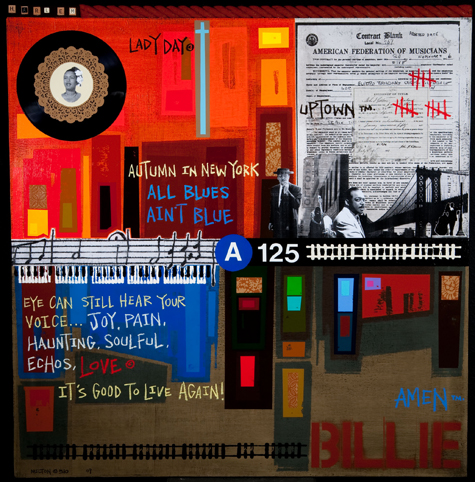
Autumn In New York
“I have two special goddaughters who help me as an artist see how art can affect young people,” he says.
Bowens works with goddaughter Mizauni, a second-grader, spending time with her as she learns to read and write. She recently won her school-wide reading competition and her family has seen “amazing success” in her educational ability since the two have been spending time together.
“I want to model what I’ve done with Mizauni to help hundreds of children in Sacramento,” Bowens says. Sacramento became the pilot city for Any Given Child, in which Bowens helped place local professional artists in schools to provide an integrated art curriculum and one-on-one interaction with students. Schools in other parts of the state, as well as in Portland, Ore., and Las Vegas, are following suit.
“We take what they are studying, like California history or ancient civilizations, and add art as a teaching mechanism,” Bowens says. “Studies have shown that students have better retention of information this way, instead of just memorization.”
Bowens says he is working toward other projects with youths, including starting a mentor diversion program in Alameda County with the juvenile court system and an art and literacy campaign in Sacramento.
“I’m getting ready to rival [my largest exhibition in Oakland] with the Art of Storytelling exhibition that will engage a program for fine art and literacy, specifically one for third grade literacy,” he says.
Bowens is basing the program off a study that upcoming correctional facilities decide on the number of beds they need by looking at the local third grade reading level.
“It’s not something terrible, it’s just if we see a problem coming, we need to prepare for it,” he says. “We need to get involved now. I’m not a minister… I’m not a counselor, I’m a painter. But I believe I have the skills to make a change and inspire young people to read.”
Some messages like this one are loud and clear in his work, while others take a little longer to see. But that’s the beauty of contemporary fine art, and though Bowens says his art “isn’t to decorate, but to educate,” he adds that he does enjoy seeing it hanging on the walls.
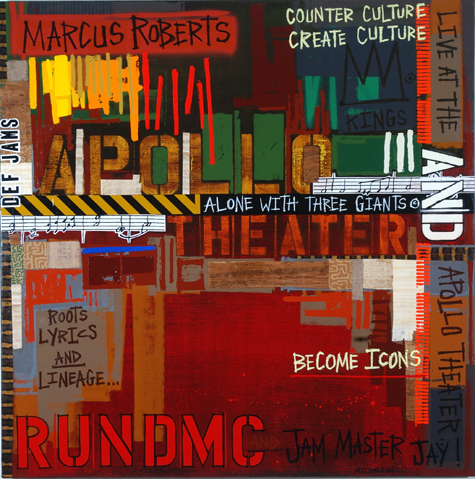
Alone With Three Giants
To catch Echoes of the Sweetest Sounds, visit Beatnik Studios at 2421 17th Street by June 26, 2012.
Gypsy Mobile Boutique brings retail revolution to Sacramento
S Street between 7th and 8th looked deserted a day before the Second Saturday bustle, until a curious 1987 Chevy step van disguised as the “little black truck” with social media icons painted in white pulled into the Howard Skinner Art Gallery parking lot.
The driver straightened up with the help of her husband, pulling the vehicle into a shaded corner.
Clad in cute heels and a floral mini dress, Bridgette Maldonado jumped out of her Gypsy Mobile Boutique, ready to set up outside for the gallery’s Pop Up Shop preview night.
Gypsy is the first of its kind in Sacramento, but the concept isn’t new. Mobile restaurants, aka food trucks, have been parking along local streets for some time in Sacramento. But none of them looks like the inside of a Midtown girl’s closet, which is the shop owner’s inspiration.
In that department, Maldonado has the local market cornered, for now.
Following the food truck phenomenon, entrepreneurs and businesses across the country are putting their creative spins on mobile retail, a reaction borne from a shaky economy. Maldonado says she has seen everything from floral arrangements to men’s haircuts sold out of trailers and school buses in Los Angeles.
“I think Sacramento is ready for something like this,” she says with a wide smile while placing colorful, thin belts on a makeshift shelf below a line of spring dresses. “L.A. can’t have all the fun.”
The Sacramento native, jewelry designer, retail visual designer and mother of two little boys (and former flight attendant and NBA pro dancer) always wanted to add “boutique owner” to her list of accomplishments, but couldn’t quite grasp the right moment or the right corner space to make it happen.
Maldonado makes her own jewelry, working in leather and clay, so she started with an Etsy shop and hoped to expand to fashion through her site. But as Etsy became inundated with similar shops, a real world presence seemed a better option.
“I would get messages from customers for something tangible–‘how does it feel, how heavy is it’–and owning a store has always been a dream of mine. But then with this economy, and the overhead, well, this was just perfect,” she says with a sigh of relief, standing in the middle of her own shop.
There are drawbacks, as with any business. Maldonado has to deal with the elements and a lack of fitting rooms and restrooms, but these mid-May days in Midtown, as well as her stops in Roseville and along office-heavy downtown streets, are advantageous and out of the way of other boutiques.
“I’ve gone to Rancho Cordova, and I park where it’s all bought-up office buildings,” she says. “Women who are working and come out on their coffee break or lunch can spend some time shopping, since there is nothing else like it nearby.”
Looking at the success of big-name designers in cities like San Francisco, Maldonado says she thinks mobile retail in Sacramento is inevitable.
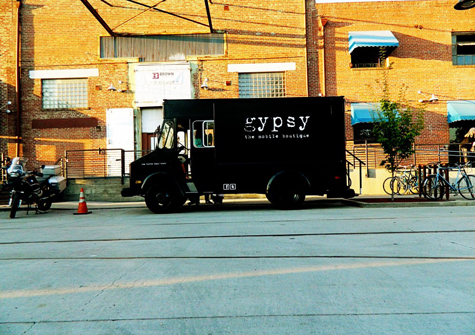
“Even in this economy, people still have the entrepreneurial spirit, and I’d welcome anyone who wants to go into this,” she says as more clothes magically appear out of hidden compartments inside the truck, lining the baby blue-painted interior. A small chandelier hangs from the truck ceiling, and the entire boutique scene comes together like a perfect date ensemble.
“It’s like food trucks. We wouldn’t have SactoMoFo [the Sacramento Mobile Food organization] if there was only one.”
Guests at the Howard Skinner Gallery, a little older than Maldonado’s target audience, stop by to ooh and ahh at the sight of maxis, minis, pastels and chunky jewelry hanging from the truck’s walls.
Pamela Skinner, along with four other organizers and designers, had invited Gypsy Mobile Boutique and food trucks to be part of the gallery’s first-ever Pop Up Shop, a similar idea to a mobile business, but leaning toward spontaneous art buying.
“The idea is ‘here today, gone tomorrow,’” Skinner says, noting the concept has popped up, like food trucks, in cities across the country and allows for artists who can’t afford a space, or don’t want to be tied down to one, to sell their work for a very limited time.
“Food trucks are very trendy right now, but pop up shops you only do a few times a year, so it’s the only time you can get what you see,” Skinner says. “People asked if we’re going to restock, and I thought it was funny. We’re not Macy’s or Walmart.”
For Maldonado, the concept is similar. She stocks what she can fit in her truck, usually one or two in each size. Once it’s gone, she looks for new items, trends and unique pieces as a way to keep things fresh for customers.
“I tell them they don’t need to wear the same thing as five other girls,” she says. “Plus, Midtown has its own unique style and I want to show that.”
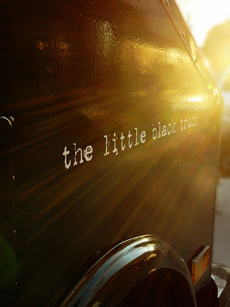
Maldonado has connected with other fashion trucks in the industry, and reached out to the West Coast Mobile Retail Association (WCMRA) that started last spring to unite shopkeepers through events, educate city officials and maintain a code of ethics to respect communities and brick and mortar stores.
“We heard from several brick-and-mortar businesses that they like the idea of a mobile business and have thought about starting a mobile business in conjunction to their brick and mortar business,” says Jeanine Romo, charter member of WCMRA and owner of Le Fashion Truck in L.A. This has been the case for local restaurants like Willie’s Burgers and Drewski’s Hot Rod Kitchen, an arm of the Republic sports bar and lounge.
“I believe that more entrepreneurs will be launching a mobile business opposed to a traditional brick-and-mortar,” Romo adds. “There are currently around 40 mobile retailers in the United States and [WCMRA] believes that number will keep growing. There will still, of course, be plenty of new brick-and-mortar businesses; however, with the popularity and low cost of being mobile, this seems to be a more attainable approach for someone going into business for themselves.”
According to WCMRA, up to $30,000 in capital is needed to start a mobile retail business, which includes the vehicle and the inventory. For the Maldonados, the cost was still more feasible than the risk of failing in a bad, permanent location.
“We considered everything from trailer to camper to a Winnebago to a school bus,” husband Marvin Maldonado says, stopping to answer his wife’s question of which dress should adorn the mannequin. “And then I get asked fashion questions too.”
It took them a few tries, but they found their truck in Pacifica, Calif. Marvin’s architecture and design company inForm designed the Gypsy caravan, gutting and renovating the vehicle to make it Bridgette-friendly and the best possible utilization of little space.
“It operates and functions just like a brick-and-mortar store but our money goes to gas and insurance instead of rent and utilities,” he says. “Plus, I can’t always be out at every event because I have my company and we have two kids, so everything has to be lightweight and dual function for her. Everything has to be thought out.”
Future upgrades still include air conditioning and, Marvin jokes, possibly chairs to put outside for husbands and boyfriends to lounge in while their significant others shop.
“I enjoy it… It’s her thing,” Marvin smiles. “I think we’re launching at the right time, and that was her goal. It’s one thing to get a truck, but it’s another to be on trend and know fashion.”
And his wife is still thinking big. Maldonado says she plans to buy another truck and sell men’s clothes, but that’s after she expands the accessory department of Gypsy. She still sells her own jewelry, as well as items like head wraps called Urban Turbans made by her sister.
It’s only been a month since Gypsy hit the streets, but Maldonado has met success at Second Saturdays, downtown Tuesday nights in Roseville and private shopping parties she hosts for customers. She’ll also be joining other designers, business owners and food trucks next month for GOOD: Street Food + Design, an open-air market to be held every first Sunday through November to increase traffic to the Del Paso Boulevard business corridor.

To see where the “little black truck” parks next, check out Gypsy Mobile Boutique on Facebook or Twitter, or go to Maldonado’s website http://gypsymobileboutique.com/
Four months and four beers strong, American River Brewing Company settles in for the long haul
The English brewed the India pale ale so that it could withstand a sea voyage to South Asia, taking into consideration choppy waters and uncontrolled temperature to create a beer still drinkable.
Brewers today make the English pale ale with these standards in mind, the result being a mellower, more balanced drink than the hoppier American version of the IPA. Head brewers David Mathis and Andy Armstrong, owners of the American River Brewing Company (ARBC) went the traditional English route with their Sunrise IPA, one of their flagship beers at the fledgling brewery out of Rancho Cordova.
“[Back then] it was supposed to be just hoppy enough and alcoholic enough to get to Bombay without bacteria forming in it,” says Mathis, leaning near four taps fastened behind a bar in the ARBC tasting room on Trade Center Drive. “We also use French oak to give the impression that it’s been sitting in a barrel for nine months.”
Though it’s 6.8 percent alcohol by volume (ABV), Sunrise is a sweeter, easier drink than its American younger brother. The floral hop bitterness equally matches the creamy malt middle, and the finish is smooth and clean.
“A beer should have a front, a middle and a back in the palate,” says Mathis, a 15-year veteran brewer, same as Armstrong. “A lot of beers I’ve had recently get rid of that middle. I want our end users to get the full pleasure out of drinking our beer.”
So far, ARBC has two other staple beers–Coloma Brown and Golden Ale–and a limited strong IPA, SSB 120, with plans to add a red ale as its fourth staple this week.
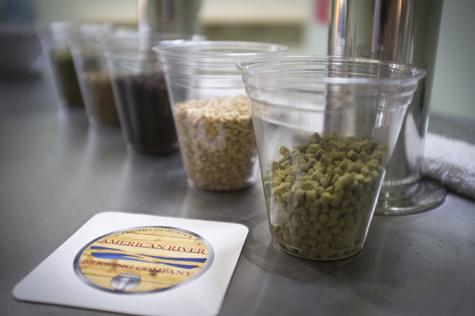
Mathis and Armstrong decided to work together on the brewery venture because they have similar tastes in beer, similar ideas on what beer should be and its future. Their compatibility and balance shows through in their creations. The Coloma Brown, named after the first gold discovery site in California, is a big beer, but at 5.5 percent ABV, not overly alcoholic. It’s like a rich chocolate malt, yet has a smooth, slightly hopped finish.
The Golden Ale is 5 percent ABV, the every-beer-drinker’s ale. It’s light, crisp and can be picked at carefully to discover the yeast and malt flavors. Just don’t drink it after having American River’s other beers, especially the SSB, or it might be hard to hit at subtleties. The SSB is a competitor for the hardiest of California IPAs, but its uniqueness is in its hops. Mathis and Armstrong stayed away from the more common American hops like Cascade and went with varieties that are comparable to European styles.
“Why would we copy what someone else was doing?” Mathis starts, “We want to find our own distinct flavor.”
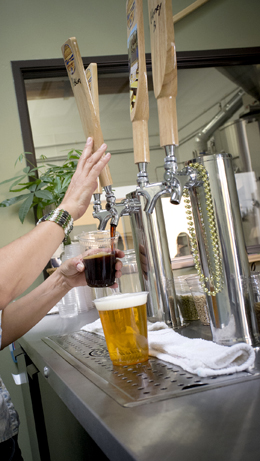
More than 15 years ago, Mathis brewed at home and loved it so much he worked for free at his local brewery until Pyramid Brewery, and later BJ’s Brewhouse, hired him. He admits to almost opening his own brewery back then, but then looks at his 15-year-old business plan and realizes it’s useless compared to what he can do now.
Armstrong and Mathis met at BJ’s, honing their craft and learning the business before deciding to see their ambitious dreams of owning a brewery come to fruition this January.
“BJ’s is good at what they do, especially with their restaurants, but they moved away from their onsite breweries,” Mathis says on why he left the corporate world. “Brewing beer is in our blood, it’s what we’re meant to do.”
Armstrong adds that he learned much of his craft at BJ’s, as well as the smaller brewery Beerman’s and U.S. sake brewer Gekkeikan.
“It was like going to beer school for nine years,” he says of BJ’s.
But he and Mathis wanted to branch out with their own creativity.
The two have a symbiotic relationship. Mathis’ marketing education is apparent, and he’s optimizing on a “grain to glass” approach to business where he and Armstrong create the recipes, choose the ingredients, do the cleaning and meet the “end user” to ensure the best possible experience.
“Sitting down and talking to guests–that’s what I’ve been doing by going to events, festivals, restaurants, bars, educating the sales staff, engaging guests about beer one person at a time,” he says.
Mathis knew Armstrong possessed the right skills and attention to detail when he chose him as his right-hand man to run the actual facility.
“One thing I learned is you have to change the light bulb if it’s out–if a guy working at a brewery is too lazy to change the light bulb, he’s too lazy to clean the fermenters properly,” Mathis says on one reason he knew Armstrong was the right guy.
Timing helps too. Mathis says what Sacramento area is seeing now is a resurgence after many breweries shut down four years ago, creating a void.
“Sacramento is one of the ripest craft brewery destinations in the nation,” he says, confident the city will join Portland, Seattle, Denver and others as a microbrewery hotspot.
ARBC Tasting Room Manager Lisa Agoitia came on board not long after the brewery opened. She is known in the local beer community, has judged past beer competitions and is studying for the Beer Judge Certification Program exam.

“I’ve known these guys for years and Andy is one of the most creative brewers I know,” she says. She and Armstrong are working together on an upcoming Incinerator Pale Ale, a blend of the brewery’s current IPA with hot peppers and jerk spices, Armstrong says.
Getting the small team started on a beer topic like this is simple when visiting the tasting room, where the three like to spend a few hours getting to know customers and talking about what’s to come.
“You don’t throw in the full pepper because you get the flavor from the skin,” says Mathis, sitting relaxed behind a barrel that’s been transformed to a tall table. “What we’re doing is figuring out how to extract only the heat… but that’s proprietary,” he laughs, refusing to give out his trade secrets.
Along with the upcoming spiced blend, Armstrong is experimenting with honey, chamomile and rosemary in future specialty beers, as well as trying barrel aging. He and Mathis filled three wine barrels with their beer to see what they can produce in limited quantity over the next year.
There is still much more room to grow. American River sits in a 6,500-square-foot industrial facility that could potentially put out 10,000 barrels per year if Mathis adds more equipment. With the current barrels, the company is capable of approximately 1,000 barrels this year, but Mathis says they’re going to take it slow.
“The market demands,” he says. “We’re getting good feedback but my focus is don’t grow so rapidly that we lose quality control or lose the connection with our end user.”
However, the long-term goal, he adds, is to make ARBC a major player like Lagunitas or Drake’s Brewing. Armstrong says he already has a few things in mind, including bottling by the end of summer and introducing new yeast strains.
They’re in it for the long haul with Rancho Cordova as headquarters. Mathis says the city council warmly welcomed the small business and is excited about ARBC’s future prospects as much as the company.
“We’re next to the highway, we have a big parking lot for trucks to turn around and the corridor connects us to the entire country,” he says.
For now, the tasting room is open Wednesday through Friday from 4 to 8 p.m., but more than a dozen bars serve American River on rotation, including de Vere’s Irish Pub, Alley Katz, River Rock Tap House, Pangaea Two Brews Cafe, Firestone Public House and the Bottle Shop in Davis.
ARBC also plans to attend the Raley Field Beer Festival May 18 and the West Coast Beer Festival at Miller Park May 19, 2012.
For more information, check out American River Brewing Company on Facebook or stop by the tasting room midweek at 11151 Trade Center Drive, Suite 104, in Rancho Cordova.














